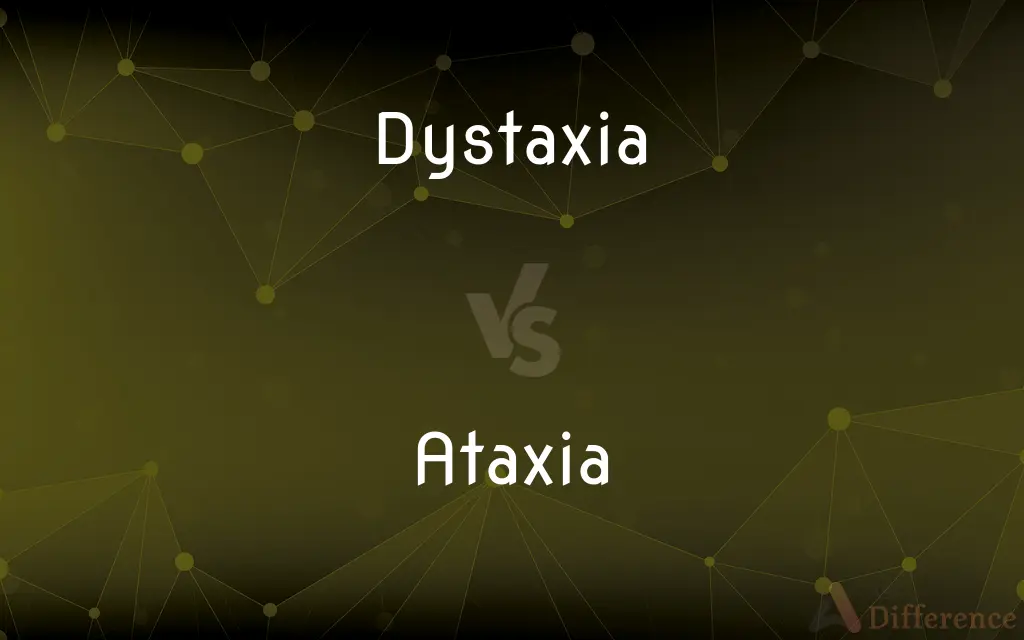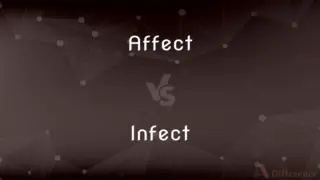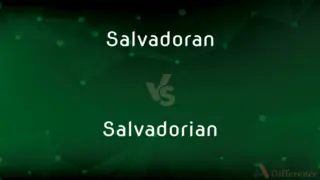Dystaxia vs. Ataxia — What's the Difference?
By Tayyaba Rehman — Updated on October 5, 2023
Dystaxia refers to mild coordination problems without muscle weakness, while Ataxia entails a lack of muscle control during voluntary movements, often due to muscle weakness or neurological issues.

Difference Between Dystaxia and Ataxia
Table of Contents
ADVERTISEMENT
Key Differences
Dystaxia and Ataxia both involve issues related to motor coordination but diverge in severity and implications. Dystaxia typically implies a milder form of motor coordination difficulty without implicating significant muscle weakness. Conversely, Ataxia presents as a more pervasive lack of muscle control or coordination of voluntary movements, which might stem from neurological issues, muscle weaknesses, or both, and can have varied underlying causes, including genetic, immune-mediated, or metabolic disorders.
In the context of Dystaxia, the affected individual might display subtle issues with coordination that might be noticeable in precise or intricate tasks. However, the basic motor functions remain largely intact and the individual does not necessarily experience overt muscle weakness. Ataxia, in contrast, encapsulates a more comprehensive range of coordination issues that can significantly impact basic motor functions, walking, speech, and even eye movements, often resulting from discernible muscle weakness or neurological perturbations.
Dystaxia might present as a slight clumsiness, subtle difficulty with tasks requiring fine motor skills, or a mild imbalance that might not necessarily impair daily functioning significantly. Whereas Ataxia often yields a pronounced impact on daily life, with individuals potentially struggling with movements, speech, and other tasks due to notable coordination difficulties and/or muscle weakness, which could be due to an underlying neurological disorder or damage.
When it comes to the medical and therapeutic interventions, Dystaxia might necessitate occupational or physical therapy to improve coordination and assist with the development of adaptive strategies for tasks requiring precision. In contrast, Ataxia, given its often more severe and pervasive nature, might require a multifaceted approach to management, involving medications, physical therapy, occupational therapy, speech therapy, and sometimes adaptive devices to facilitate mobility and communication.
While both Dystaxia and Ataxia are manifested in coordination issues, Dystaxia typically embodies a milder form, potentially only evident in certain contexts or specific activities. In contrast, Ataxia usually signifies a more encompassing and noticeable struggle with coordination and muscle control, impacting numerous aspects of daily life and functionality.
ADVERTISEMENT
Comparison Chart
Severity
Generally mild
Can be severe
Muscle Weakness
Not typically present
Often present
Impact on Daily Life
May be minimal
Can be significant
Underlying Mechanism
Motor coordination difficulty
Lack of muscle control or coordination
Therapeutic Approach
Typically less intensive
Often multifaceted and more intensive
Compare with Definitions
Dystaxia
Minor Motor Skill Difficulty
Buttoning his shirt was complicated by dystaxia.
Ataxia
Motor Function Disruption
His speech was slurred, indicative of ataxia.
Dystaxia
Subtle Balance Problem
Her dystaxia made tightrope walking a challenging task.
Ataxia
Lack of Muscle Control
Ataxia caused her to struggle with stable walking.
Dystaxia
Gentle Motor Inaccuracy
Her dystaxia was noticeable when threading a needle.
Ataxia
Imbalanced Gait
The man walked with a stagger due to ataxia.
Dystaxia
Mild Coordination Issue
His dystaxia manifested as slight clumsiness while writing.
Ataxia
Impaired Coordination
Due to ataxia, he found it difficult to grasp objects.
Dystaxia
Light Motor Control Difficulty
His dystaxia made handwriting appear shaky.
Ataxia
Unsteady Movements
Her dance was visibly impacted by ataxia.
Dystaxia
A milder or weaker form of ataxia
Ataxia
Ataxia is a neurological sign consisting of lack of voluntary coordination of muscle movements that can include gait abnormality, speech changes, and abnormalities in eye movements. Ataxia is a clinical manifestation indicating dysfunction of the parts of the nervous system that coordinate movement, such as the cerebellum.
Ataxia
The loss of full control of bodily movements.
Ataxia
Loss of the ability to coordinate muscular movement.
Ataxia
Any of various degenerative, often hereditary, disorders that are characterized by ataxia and are frequently associated with cerebellar atrophy.
Ataxia
(pathology) Lack of coordination while performing voluntary movements, which may appear to be clumsiness, inaccuracy, or instability.
Ataxia
(chemistry) The condition of a polymer in which the orientation of the subunits is random
Ataxia
(obsolete) Disorder; irregularity.
Ataxia
Disorder; irregularity.
Ataxia
Irregularity in disease, or in the functions.
Ataxia
Loss of coordination in the voluntary muscles, especially the limbs; an inability to coordinate voluntary muscle movements; it results in unsteady movements and a staggering gait. See also locomotor ataxia, an ataxia which occurs when attempting to perform coordinated muscular movements.
Ataxia
Inability to coordinate voluntary muscle movements; unsteady movements and staggering gait
Common Curiosities
Can ataxia affect speech?
Yes, ataxia can impair speech due to coordination issues.
Is ataxia always genetic?
No, ataxia can have various causes, including genetic, metabolic, or immune-mediated.
Is dystaxia a severe disorder?
Dystaxia typically implies mild coordination problems.
How is ataxia diagnosed?
Ataxia is diagnosed through clinical evaluation, and possibly genetic testing or imaging.
Does ataxia progressively worsen?
Some forms of ataxia can be progressive, while others might remain stable.
Are there different types of ataxia?
Yes, there are various forms of ataxia, often categorized by their cause.
Can lifestyle changes manage ataxia?
Lifestyle adjustments can support management but not alleviate ataxia.
Does dystaxia involve muscle weakness?
Dystaxia does not typically involve notable muscle weakness.
Can dystaxia be improved with therapy?
Yes, physical and occupational therapy might benefit individuals with dystaxia.
Is dystaxia recognizable in early childhood?
Dystaxia may be recognizable if it notably impacts coordination in a child.
Can dystaxia be a standalone diagnosis?
Dystaxia might be recognized independently or as part of another condition.
Can dystaxia be noticed in speech?
It's possible, but dystaxia typically involves milder issues than ataxia.
Can dystaxia affect adults?
Yes, dystaxia can affect individuals at any age.
Are dystaxia and ataxia life-threatening?
Neither is inherently life-threatening but can impact quality of life differently.
Can ataxia be treated?
Ataxia management may involve therapy and medications, though it's not curable.
Share Your Discovery

Previous Comparison
Affect vs. Infect
Next Comparison
Salvadoran vs. SalvadorianAuthor Spotlight
Written by
Tayyaba RehmanTayyaba Rehman is a distinguished writer, currently serving as a primary contributor to askdifference.com. As a researcher in semantics and etymology, Tayyaba's passion for the complexity of languages and their distinctions has found a perfect home on the platform. Tayyaba delves into the intricacies of language, distinguishing between commonly confused words and phrases, thereby providing clarity for readers worldwide.















































